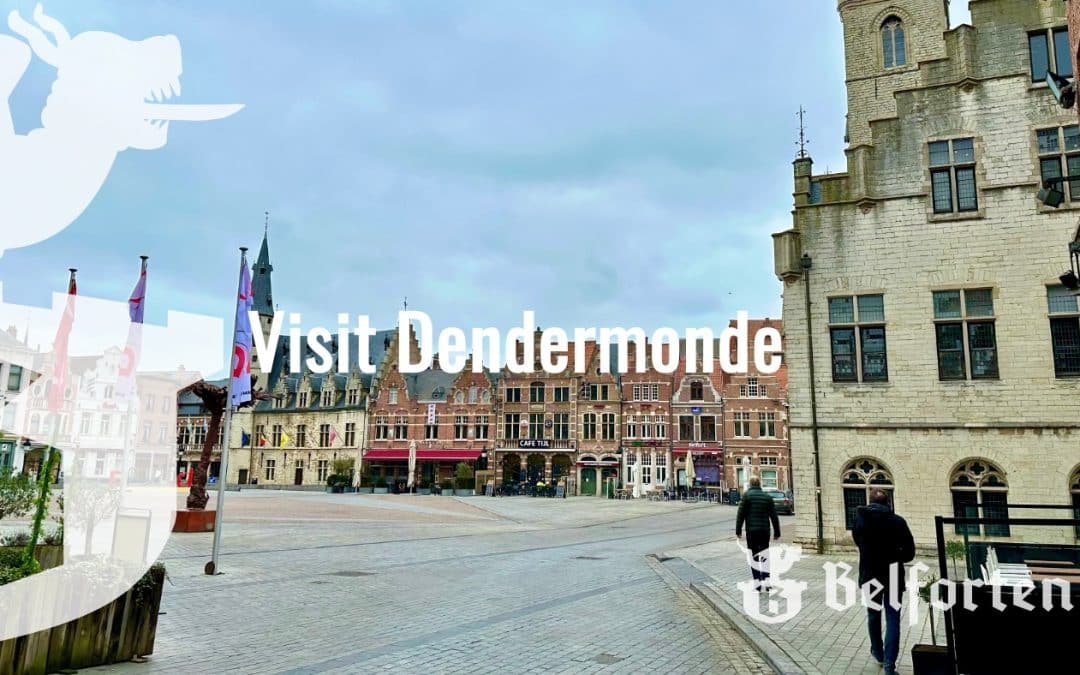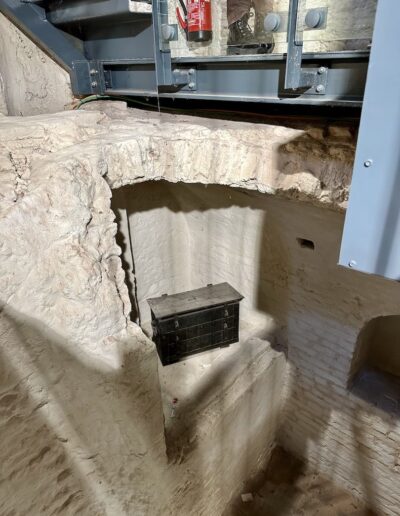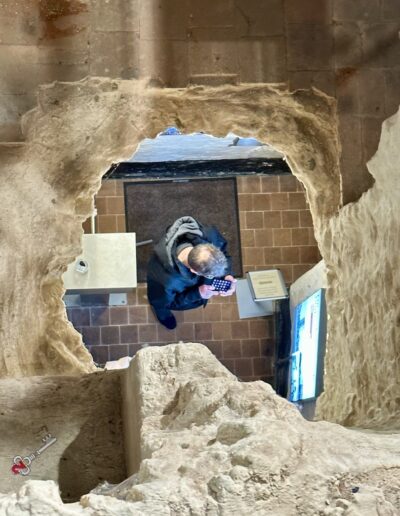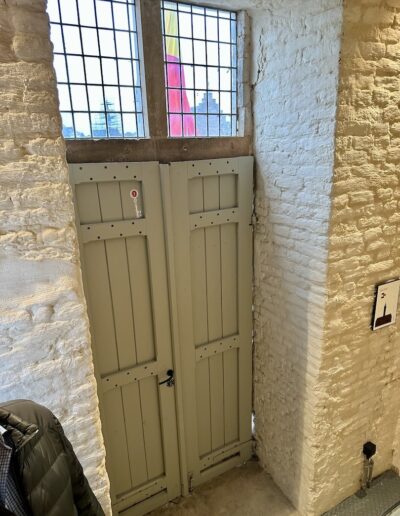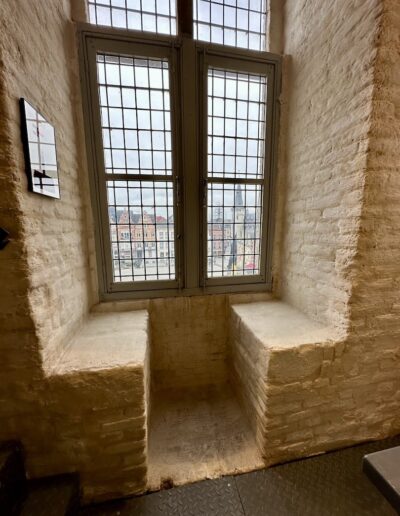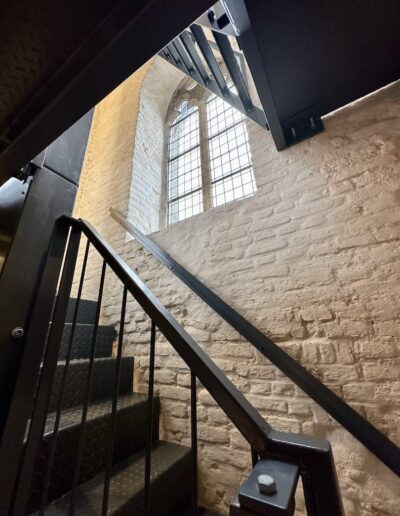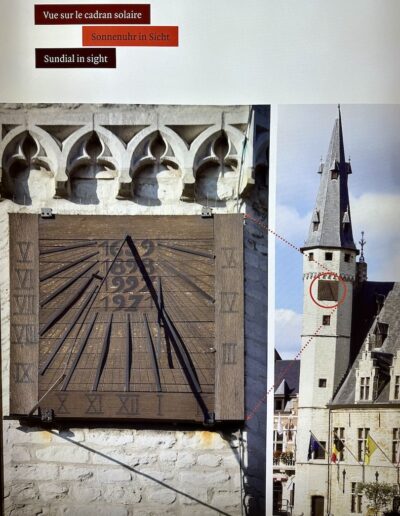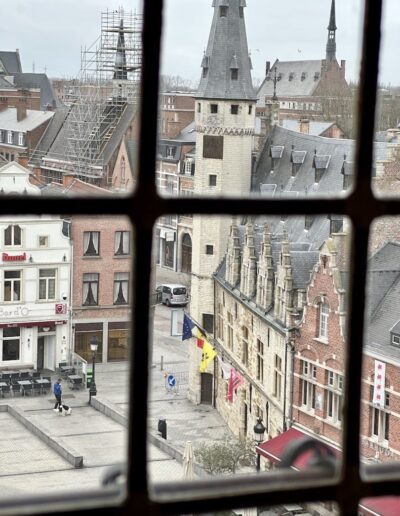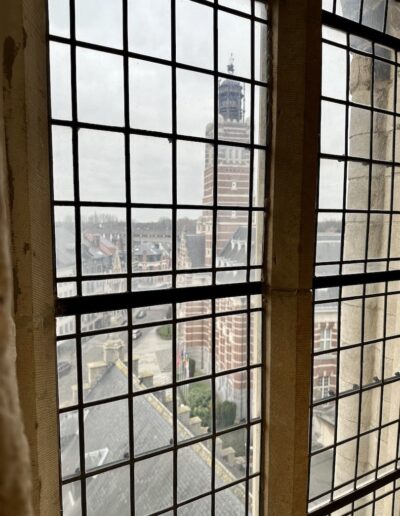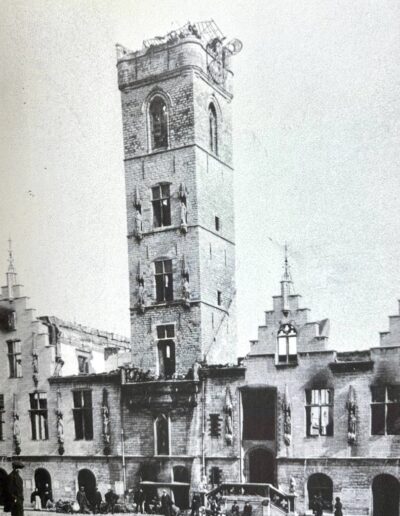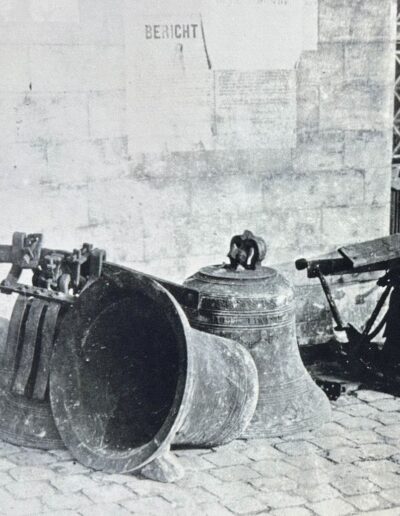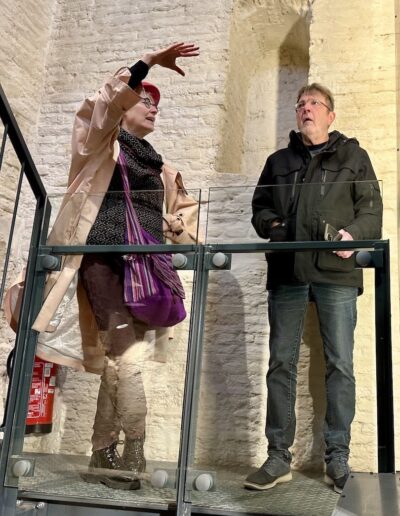Visit Belfry of Dendermonde 2023
Rein had managed to get in touch with Patrick Segers, the head of the Tourism Department in Dendermonde, and make an appointment to tour the Belfry. Not only was Patrick waiting for us in front of the Belfry and City Hall but he turned out to be in the company of Gretel Laureys, one of Dendermonde’s 15 city guides. City carillonneur Lorenz Meulenbroek was unfortunately unable to attend. For this, we will have to come back again so we can see the carillon as well.
Right into the Belfry Tower
The Belfry Tower can be entered through a door that opens onto the Grand Place, and since 2018 it has been possible to do so with the help of an audio guide. We are fortunate to have Gretel, armed with a folder of additional information and photos, tell us all about the Belfry. It is good to mention that the stairs in the Belfry are not accessible to everyone because they are steep and narrow. The way up is partly by the original stone steps but most of it by recent steel steps. Why this is becomes clear immediately upon entering the Belfry: from the first floor, you can see all the way up through the Belfry shaft to below the floor of the carillon. After an impact of a German shell in 1914, bells of the carillon broke loose and thundered down, punching a huge hole through all the floors down to the first floor.
The Secret
The brochure “A Virtual Visit Belfry of Dendermonde” saves us counting the steps. After 32 steps, we reach the second floor with the secret or secret room of the Belfry. See the third photo above showing the original archive case in the vaulted alcove. The walls of the Belfry are at their thickest here to protect the case and its important contents. This room used to be accessible only from City Hall and required six keys to enter. Only in the presence of the six key holders could the case be opened. The suitcase contained all the important documents including the city charter from 1233.
The balcony
We go up 6 steps again and enter the room with the doors to the balcony. When there was something to report that concerned the whole town, the doors were opened so that the town crier, by profession “Belleman,” could address the population. Or rather, shouting at him because it took a loud voice to be heard by the people in the Grand Place.
From Gretel’s folder emerges a map showing the defensive line around Antwerp in 1914. Dendermonde was not directly a part of it, but it got a very hard time just the same. The German army wanted to cross the Scheldt via Dendermonde in order to bypass the defense ring. Dendermonde did not respond to the ultimatum to cooperate in this was then set on fire. Almost the entire city was reduced to ashes in the process. A futile act because the Germans turned toward Paris after this.
The lookout
We then go up another 21 steps to the lookout (3rd photo above). This is where the city guard watched over the city at night. The houses in medieval and densely populated Dendermonde were mainly made of wood, and fire was therefore the main danger lurking. In addition to monitoring from the Belfry, tours of the city were made to see that people put out fires and candles in their homes. Violators were allowed to be arrested.
The clockwork room
The floor above the lookout (83 steps) housed the city watch before World War I. Between four in the morning and eight at night, this mechanism ensured that the clock struck every whole hour. The movement was powered by weights that were pulled up each day by the “watch master.
From this room you have a view of the 1659 sundial of the Meat House.
The Carillon
As early as 1529, the hour bell was given a front strike consisting of 6 bells (cast by J. Waghevens of Mechelen). In 1548 a chime of 15 bells from the same bell foundry was added, and in 1560 the first carillon keyboard was attached. These are replaced by a new carillon cast by P. Van den Gheyn from the Mechelen family of bellfounders. 24 bells of these were destroyed by the 1914 grenade attack.
A new carillon of 40 bells cast by Bell Foundry Omer Michaux (Brussels) was installed in 1925. These were replaced in 1950 by a completely new carillon consisting of 49 bells (cast by M. Michiels). The present carillon was fitted in 1975 with a new bass bell and 8 new discant bells by bell-founder J. Sergeys of Antwerp.
Panorama
Then we have 109 steps and are in the Panorama Room. No higher, unfortunately, because the hatch to the spire is locked. Had we managed to visit Dendermonde at a different (later) time, city carillonneur Lorenz Meulebroek would probably have taken us even further up the mountain. During the descent, it then becomes apparent how steep the stairs are when Gretel sprains. So down with caution!
The front of the Belfry
Coming down, we went into the Grand Place to see the front of the Belfry. Gretel especially dwells on the sculptures on the facades. The statues next to the windows of the first and second floors of the old cloth hall were installed in 1895 and were created by Aloïs De Beule of Zele. They introduce the gentlemen and women of Dendermonde. On the second floor Walter II and Mathilde I of Dendermonde, Robrecht I, Mathilde II and Robrecht II of Bethune. On the second floor, we see Daniel of Dendermonde and Crusader Walter I.
The belfry tower is adorned with a statue of Our Lady with Child made by Dendermond sculptor Jeanne De Dijn (it stands on the site of an earlier wooden specimen now on display at Het Vleeshuis). Above them, four statues placed in 1894. Created by Octave Maes (Dendermonde), they depict Saint Hilduardus and Saint Christiana, patron saints of the city, Reingot I the Bald, founder of the Church of Our Lady, and Reingot II, founder of the chapter of canons.
On the railing of the City Hall staircase are two lions (also created by Octave Maes). The five statues next to the first-floor windows are William of Dampierre, William of Nesle, John of Flanders, Beatrix of St. Pol and Mary of Flanders. The statues were made by Van Hove of Wetteren and they were installed in 1895.
After this, we are taken to the Dendermonde City Hall in for a comprehensive tour and visit the Dutch Barracks. Also very interesting! Should you visit Dendermonde sometime, we heartily recommend Gretel or her colleagues! A guided tour can be booked through Tourism Dendermonde. We say goodbye to Gretel in front of the belfry tower and wish her a speedy recovery from the earlier tumble.
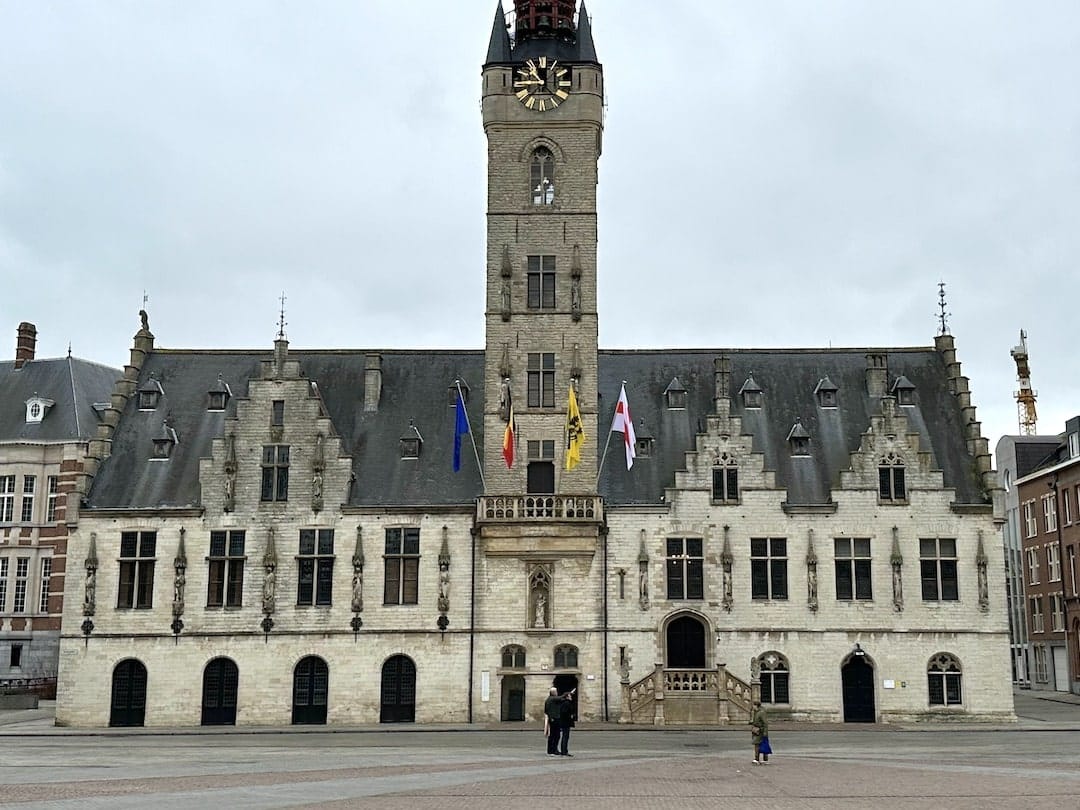
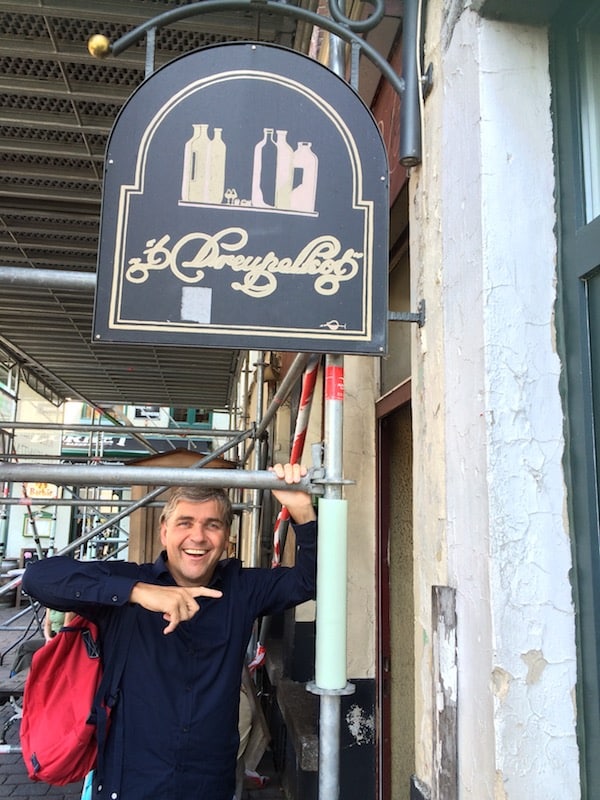
Eric Cornelissen
Wanneer het was is niet meer bekend maar tijdens een editie van de Gentse Feesten ontstond de interesse in de geschiedenis en de betekenis van Belforts. Met een vette knipoog naar Reinhold Messner die als eerste de veertien hoogste toppen van de wereld beklom moest iemand maar eens de eerste zijn die alle belforten van de Lage Landen gaat beklimmen! Pas later werd duidelijk dat het er geen 14 maar 56 zijn. Die Messner had het maar makkelijk.
